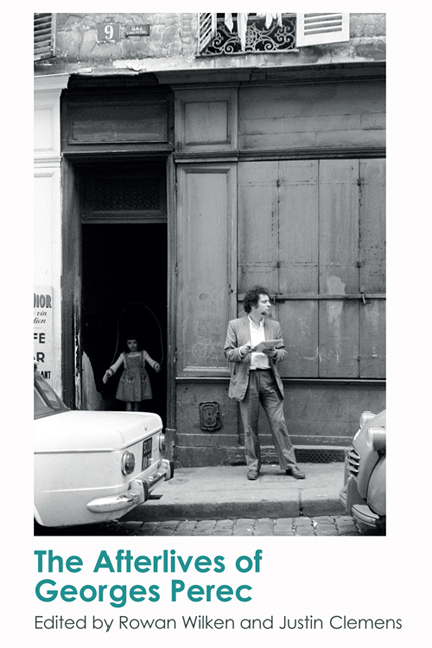Book contents
- Frontmatter
- Contents
- List of Figures
- Acknowledgements
- Notes on Contributors
- 1 Posthumous News: The Afterlives of Georges Perec
- PART I Art of the (Un)realisable
- 2 Georges Perec's Enduring Presence in the Visual Arts
- 3 Apoetic Life: Perec, Poetry, Pneumatology
- 4 UnSearching for Rue Simon-Crubellier: Perec Out-of-Sync
- 5 Invoking the Oracle: Perec, Algorithms and Conceptual Writing
- PART II The Poetics of the Quotidian and Urban Space
- PART III Ludic Intensities and Creative Constraints
- PART IV Productive Problems of Description and Transcription
- Afterword
- Index
3 - Apoetic Life: Perec, Poetry, Pneumatology
from PART I - Art of the (Un)realisable
Published online by Cambridge University Press: 07 December 2017
- Frontmatter
- Contents
- List of Figures
- Acknowledgements
- Notes on Contributors
- 1 Posthumous News: The Afterlives of Georges Perec
- PART I Art of the (Un)realisable
- 2 Georges Perec's Enduring Presence in the Visual Arts
- 3 Apoetic Life: Perec, Poetry, Pneumatology
- 4 UnSearching for Rue Simon-Crubellier: Perec Out-of-Sync
- 5 Invoking the Oracle: Perec, Algorithms and Conceptual Writing
- PART II The Poetics of the Quotidian and Urban Space
- PART III Ludic Intensities and Creative Constraints
- PART IV Productive Problems of Description and Transcription
- Afterword
- Index
Summary
… To be worst,
The lowest and most dejected thing of fortune,
Stands still in experience, lives not in fear.
The lamentable change is from the best,
The worst returns to laughter.
William Shakespeare, The History of King Lear (1608), 4.1.2–6… To be worst,
The lowest and most dejected thing of fortune,
Stands still in esperance, lives not in fear.
The lamentable change is from the best,
The worst returns to laughter.
William Shakespeare, The Tragedy of King Lear (1623), 4.1.2–6PREPOTENTIAL CONSTRAINT: EXPRESSION AT A STANDSTILL
Once ‘constraint’ has become a fundamental theme, it is almost impossible to know where it begins or ends. If, in regard to composition, the term has now perhaps acquired a primarily technical signification, it should not be forgotten that it derives from the Latin for binding together, tied, inhibited or compressed. The Oxford English Dictionary gives such meanings as ‘the exercise of force to determine or confine action; coercion, compulsion’; ‘compulsion of circumstances, necessity of the case’; ‘confinement, bound or fettered condition; restriction of liberty or of free action’; ‘pressure of trouble or misfortune; oppression, affliction, distress’. Constraint implies pain, coercion and incarceration, with political, theological and even ontological overtones.
In the two major independent extant printed play texts of Shakespeare's King Lear, the first a 1608 quarto version, the second appearing in the 1623 First Folio – which make Lear a work with at least two different titles, each denominating a different genre – there are also a large number of other variations: missing, extra or different words, lines and punctuation. If the scholarly wrangling over the provenance and significance of these divergences is unlikely to find happy resolution in any foreseeable circumstances, following their vicissitudes returns us to the volatile and violent problematic of constraint.
Indeed, once one starts to ask such questions, it is difficult to stop: not only because we are lacking essential historical details, but because the principles which might enable a decision regarding these ever-differentiating differences are themselves lacking.
- Type
- Chapter
- Information
- The Afterlives of Georges Perec , pp. 45 - 68Publisher: Edinburgh University PressPrint publication year: 2017

